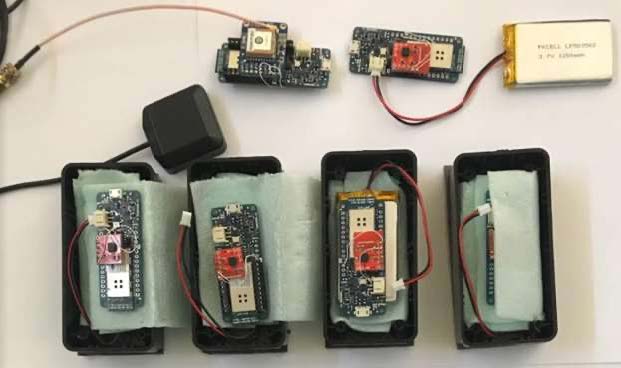News | PSR Researcher Chun-Hsing Ho Identifies Cost-Effective Sensor Technology for Pavement Deterioration and Distress
Stop the VideoNews

PSR Researcher Chun-Hsing Ho Identifies Cost-Effective Sensor Technology for Pavement Deterioration and Distress
Thursday, July 1, 2021
Deteriorating roads, distressed pavement, and an abundance of road obstacles like potholes can create detrimental consequences for local communities, drivers, and pedestrians. The need for consistent city maintenance of roads remains a constant fiscal challenge. The traditional method for monitoring road conditions is time and labor intensive: vehicles with monitoring equipment are periodically driven along each road. Automated technologies can be utilized to aid in the detection of pavement distress, which may lessen long-term costs. Specifically, automated tech simplifies methods of monitoring road quality and streamlines data collection by reducing the need for extensive human labor or costs. However, despite the necessity of automated systems in monitoring road quality, current methods are often implemented inconsistently by highway agencies, who may not use uniform methods of data collection. High initial cost and investment in the required software serves as a significant barrier. Feasibility and efficacy of cost-effective vibration and sensor models is thus a high priority for monitoring road conditions to create an alternative to the existing outdated and limited technology.
To compare the efficacy of cost-effective models, a team of researchers funded by the Pacific Southwest Region University Transportation Center (PSR) studies pavement distress assessment methods. The research team included Northern Arizona University (NAU) Associate Professor of Civil Engineering, Construction Management, and Environmental Engineering Chun-Hsing Ho; Graduate Research Assistant Dada Zhang; Graduate Research Assistant Jaiwei Gao; Associate Professor at the School of Informatics, Computing, and Cyber Systems Marco Gerosa; and Professor at the School of Informatics, Computing, and Cyber Systems Bertrand Cambou. In the PSR-funded project, Development of Cost-Effective Sensing Systems and Analytics (CeSSA) to Monitor Roadway Conditions and Mobility Safety, the researchers sought to identify computing models capable of predicting distress, study the most efficient placement of vehicle sensor loggers, and develop affordable government and community tools to determine road quality and provide needed repairs.
The study used data from a previous 2017-2018 study on Phoenix’s I-10 highway, which includes data on pavement vibration and temperature, as well as how each of the vehicle and iPhone-based sensors performed in comparison to the others. The data were used to conduct a test of four distinct machine learning models including Random Forest (RF), Neural Network (NN) Logistic Regression (LR), and Support Vector Machine (SVM), using a scale of good/fair/poor to scale pavement condition. In addition to testing the four models, the researchers also analyzed the effect of temperature on pavement distress and the most effective location of sensors.
The study yielded several significant results. The team concluded that the RF (Random Forest) algorithm has the highest efficacy and overall accuracy compared to the other models. Overall, they found that CeSSA technology is sufficiently able to determine vibration patterns and distress. Other observed results included the positive correlation between temperature and pavement distress, where higher temperatures are associated with a greater extent of distress. The final data set for the project may be found at https://doi.org/10.7910/DVN/MGGWCN.
Road quality and pavement stress continue to be significant issues in transportation infrastructure. According to a 2016 research report by TRIP, a transportation research organization, approximately 32% of the country’s roads in major urban areas are in poor condition, with just 28% being considered “good.” The substandard quality costs drivers using these roads close to $112 billion annually in repairs and maintenance costs, impacts that are exacerbated by increasing road usage rates as more vehicles utilize the road. The recent research contribution by Ho, Zhang, Gao, Gerosa, and Cambou provides important information on the efficacy of new cost-effective sensors for road quality management, which may prove to be an integral part of developing more efficient and consistent road repair systems in the future.

News Archive
- December (1)
- November (6)
- October (4)
- September (2)
- August (3)
- July (4)
- June (3)
- May (7)
- April (8)
- March (11)
- February (8)
- January (7)
- December (7)
- November (8)
- October (11)
- September (11)
- August (4)
- July (10)
- June (9)
- May (2)
- April (12)
- March (8)
- February (7)
- January (11)
- December (11)
- November (5)
- October (16)
- September (7)
- August (5)
- July (13)
- June (5)
- May (5)
- April (7)
- March (5)
- February (3)
- January (4)
- December (4)
- November (5)
- October (5)
- September (4)
- August (4)
- July (6)
- June (8)
- May (4)
- April (6)
- March (6)
- February (7)
- January (7)
- December (8)
- November (8)
- October (8)
- September (15)
- August (5)
- July (6)
- June (7)
- May (5)
- April (8)
- March (7)
- February (10)
- January (12)















